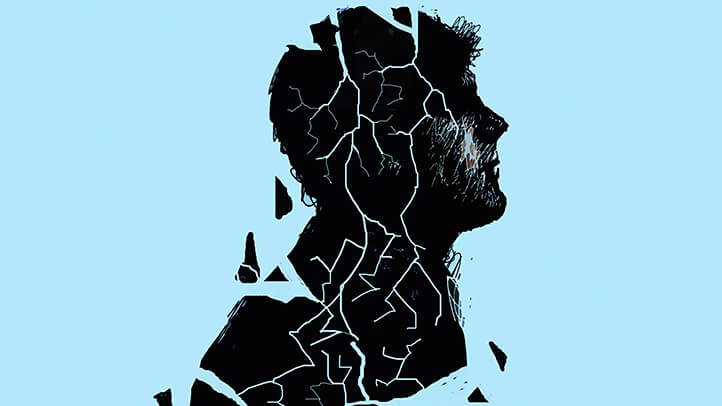Do You Know About Borderline Personality Disorder?

Surely you’ve heard about borderline personality disorder. A borderline refers to a barrier, a frontier, the limit that separates two parts. Usually, this is a sensation that very well identifies this disorder. People who suffer from it in some way feel like they are at the edge of something. This is something we will delve more into throughout this article.
A closer look at personality disorders
Personality disorders imply an established pattern of behaviors, thoughts and emotions that are maladaptive for the person who experiences them and for their surroundings.
We all have certain traits from these disorders. Some of us feel more identified with certain ones rather than others, but everyone has personality traits that tend to belong to certain disorders. There are people, for example, who are extremely effusive, vivacious, and active.

This could be confused with mania (characteristic of bipolar disorder), but as long as they don’t meet a certain set of requirements, it doesn’t necessarily imply anything other than that.
The fundamental requirements to suspect a personality disorder implies that they meet all of the criteria necessary to be diagnosed with the disorder. Also, it needs to seriously affect their social and personal relationships, and other aspects of their everyday life (work, home, coworkers, friends, etc.)
Personality disorders generate discomfort and suffering
The person may suffer, but it’s a suffering which they try to accept because they think it’s inevitable. Furthermore, it’s common that they also won’t identify this suffering as a consequence of the way they behave or perceive the world.

As the DSM-IV-TR defines it, “a personality disorder is a permanent and inflexible pattern of inner experience and behavior which differs acutely from the expectations of the individual’s culture. It begins during adolescence or early adulthood. It is stable over time and provides discomfort and prejudice for the individual”.
Characteristics of borderline personality disorder
In borderline personality disorder there is a set of very prototypical traits:
- For them, it’s a source of extreme suffering to think that someone is going to abandon them. That’s why they make desperate efforts to prevent this from happening, especially with their friends, partners and family members. In fact, as a form of protection, before they are abandoned by others, they are the ones who leave. They are the ones who choose to reject others. Paradoxically, what they seek is not to separate from that person. Yet, the suffering caused by this “possible abandonment” is such that they need to resort to this defense mechanism.
- The interpersonal relationships they maintain with others are unstable and seem to alternate between episodes of idealization and absolute devaluation. In the idealization stage, they think of the other person as amazing and view them as an earthly god. Then, they become someone despicable and bad.

The distortion of their self-image
- Their self-image is distorted and very unstable. It’s common for personality disorders to also be associated with eating disorders. Bulimia is one of the most common ones involved. This has a lot to do with that brutal impulsiveness they feel and need to channel. Many times they perform behaviors that might be rash or reckless. Be it excessive expenses, the consumption of certain substances or sex addiction.
- In regards to their emotions, these tend to change quite a lot. They can easily go from a depressive mood to a very enthusiastic one. They tend to feel a lot of anxiety, something that makes them live in a state of constant irritability. These changes can vary within hours or days. At the end of the day, the very unstable relationships they maintain with others are simply a reflection of the relationship they have with themselves. This generates a great deal of suffering that they oftentimes accept as something impervious and eternal.
- These individuals tend to feel guilt and shame when they have fits of rage or aggression. This is something that makes them seem like “evil” or “bad” people who will never change. They end up accepting this as a reality, and it’s hard for them to change this image they have of themselves.

Filling a relentless void
- There’s a symptom that is very characteristic of this disorder, and it’s the chronic feeling of emptiness they experience. It’s as if they were incapable of filling that void they feel. No matter how many impulsive, reckless, expansive behaviors they have… it’s never enough. They need that excessive stimulation in order to not feel the void. But the sensation always comes back over and over, it never disappears.
- Dissociative symptoms, in turn, are very frequent and emerge during episodes of pronounced stress. It’s as if they thought one thing and felt something completely different. As if they were two completely different sides of the same person. All of this hinders the feeling of integration within the individual. It’s as if everything appeared disintegrated and couldn’t fix it, because they haven’t yet learned how to do so. .
That’s why psychotherapy is a very important aid for people who are diagnosed with Borderline personality disorder. Psychotherapy as a tool that will help them manage and be aware of all of their difficulties, socially as well as emotionally.
Here, to conclude, we leave you a video in which this disorder is explained from a very personal point of view.
Surely you’ve heard about borderline personality disorder. A borderline refers to a barrier, a frontier, the limit that separates two parts. Usually, this is a sensation that very well identifies this disorder. People who suffer from it in some way feel like they are at the edge of something. This is something we will delve more into throughout this article.
A closer look at personality disorders
Personality disorders imply an established pattern of behaviors, thoughts and emotions that are maladaptive for the person who experiences them and for their surroundings.
We all have certain traits from these disorders. Some of us feel more identified with certain ones rather than others, but everyone has personality traits that tend to belong to certain disorders. There are people, for example, who are extremely effusive, vivacious, and active.

This could be confused with mania (characteristic of bipolar disorder), but as long as they don’t meet a certain set of requirements, it doesn’t necessarily imply anything other than that.
The fundamental requirements to suspect a personality disorder implies that they meet all of the criteria necessary to be diagnosed with the disorder. Also, it needs to seriously affect their social and personal relationships, and other aspects of their everyday life (work, home, coworkers, friends, etc.)
Personality disorders generate discomfort and suffering
The person may suffer, but it’s a suffering which they try to accept because they think it’s inevitable. Furthermore, it’s common that they also won’t identify this suffering as a consequence of the way they behave or perceive the world.

As the DSM-IV-TR defines it, “a personality disorder is a permanent and inflexible pattern of inner experience and behavior which differs acutely from the expectations of the individual’s culture. It begins during adolescence or early adulthood. It is stable over time and provides discomfort and prejudice for the individual”.
Characteristics of borderline personality disorder
In borderline personality disorder there is a set of very prototypical traits:
- For them, it’s a source of extreme suffering to think that someone is going to abandon them. That’s why they make desperate efforts to prevent this from happening, especially with their friends, partners and family members. In fact, as a form of protection, before they are abandoned by others, they are the ones who leave. They are the ones who choose to reject others. Paradoxically, what they seek is not to separate from that person. Yet, the suffering caused by this “possible abandonment” is such that they need to resort to this defense mechanism.
- The interpersonal relationships they maintain with others are unstable and seem to alternate between episodes of idealization and absolute devaluation. In the idealization stage, they think of the other person as amazing and view them as an earthly god. Then, they become someone despicable and bad.

The distortion of their self-image
- Their self-image is distorted and very unstable. It’s common for personality disorders to also be associated with eating disorders. Bulimia is one of the most common ones involved. This has a lot to do with that brutal impulsiveness they feel and need to channel. Many times they perform behaviors that might be rash or reckless. Be it excessive expenses, the consumption of certain substances or sex addiction.
- In regards to their emotions, these tend to change quite a lot. They can easily go from a depressive mood to a very enthusiastic one. They tend to feel a lot of anxiety, something that makes them live in a state of constant irritability. These changes can vary within hours or days. At the end of the day, the very unstable relationships they maintain with others are simply a reflection of the relationship they have with themselves. This generates a great deal of suffering that they oftentimes accept as something impervious and eternal.
- These individuals tend to feel guilt and shame when they have fits of rage or aggression. This is something that makes them seem like “evil” or “bad” people who will never change. They end up accepting this as a reality, and it’s hard for them to change this image they have of themselves.

Filling a relentless void
- There’s a symptom that is very characteristic of this disorder, and it’s the chronic feeling of emptiness they experience. It’s as if they were incapable of filling that void they feel. No matter how many impulsive, reckless, expansive behaviors they have… it’s never enough. They need that excessive stimulation in order to not feel the void. But the sensation always comes back over and over, it never disappears.
- Dissociative symptoms, in turn, are very frequent and emerge during episodes of pronounced stress. It’s as if they thought one thing and felt something completely different. As if they were two completely different sides of the same person. All of this hinders the feeling of integration within the individual. It’s as if everything appeared disintegrated and couldn’t fix it, because they haven’t yet learned how to do so. .
That’s why psychotherapy is a very important aid for people who are diagnosed with Borderline personality disorder. Psychotherapy as a tool that will help them manage and be aware of all of their difficulties, socially as well as emotionally.
Here, to conclude, we leave you a video in which this disorder is explained from a very personal point of view.
This text is provided for informational purposes only and does not replace consultation with a professional. If in doubt, consult your specialist.







